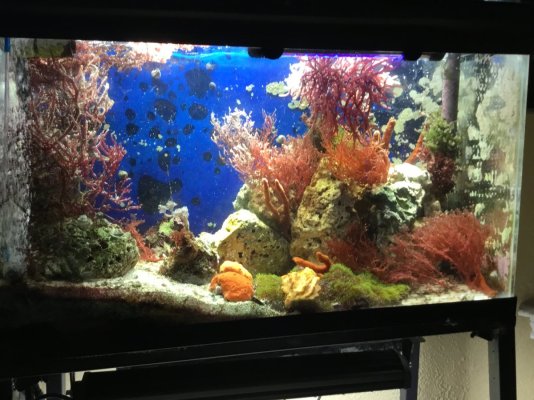Randy Holmes-Farley
Reef Chemist
View Badges

Staff member
Super Moderator
Excellence Award
Expert Contributor
Article Contributor
R2R Research
My Tank Thread
Elevated nutrients are one of the most talked about issues in reefkeeping, with folks on all sides of the issue.
There is, however, no simple answer to the title question (IMO).
I thought I'd start a thread for a wide ranging discussion of this issue, and to gather many of the bits of data and anecdotes and comments in one place.
I'll start off with a few ideas to provide some background and ideas to debate.
1. It is clear that there are great reef tanks that most hobbyists admire with nutrients (nitrate and phosphate, particularly) ranging from low levels (say, less than 2 ppm nitrate and 0.01 ppm phosphate) up to quite high levels (>1 ppm phosphate and >100 ppm nitrate).
2. It is clear that there are reef tanks overrun with bryopsis, valonia, green hair algae, caulerpa, dinos, cyano, or other problems at nearly any of the values mentioned in 1.
3. Scientific studies on the effects of elevated nutrients on growth of hard corals are mixed. In some studies they thrive. In some studies they do not. In some studies, some growth forms (e.g., encrusting) are decreased and others (e.g., linear growth) of the same coral are increased. In most study cases, these are not getting the natural particulate foods they would get in the wild, and how much of what particulate foods they get in aquaria likely varies greatly based on husbandry techniques used.
4. Scientific studies on elevated nutrients in the ocean often suggest that hard corals decline and other organisms take over. This result is, of course, not due to solely to effects of nutrients on corals, but to effects on competing organisms as well.
Since a reef aquarium is, in some ways, a small microcosm of the real ocean, I think point 4 should not be dismissed, even knowing that point 1 is valid.
Perhaps point 1 is only valid for elevated nutrients if there are other aspects of the aquarium that allow hard corals to thrive. For example, herbivores to control algae.
Here, for example, is a recent analysis relating to hard corals in the ocean with elevated nutrients:
A new perspective of nutrient management of subtropical coastal stress-tolerant scleractinian coral communities

 www.sciencedirect.com
www.sciencedirect.com
from it:
Elevated nutrients decrease the healthy status of coral communities, which can be stressful on reef corals, always resulting in decreased live scleractinian coral cover (LSCC).
There is, however, no simple answer to the title question (IMO).
I thought I'd start a thread for a wide ranging discussion of this issue, and to gather many of the bits of data and anecdotes and comments in one place.
I'll start off with a few ideas to provide some background and ideas to debate.
1. It is clear that there are great reef tanks that most hobbyists admire with nutrients (nitrate and phosphate, particularly) ranging from low levels (say, less than 2 ppm nitrate and 0.01 ppm phosphate) up to quite high levels (>1 ppm phosphate and >100 ppm nitrate).
2. It is clear that there are reef tanks overrun with bryopsis, valonia, green hair algae, caulerpa, dinos, cyano, or other problems at nearly any of the values mentioned in 1.
3. Scientific studies on the effects of elevated nutrients on growth of hard corals are mixed. In some studies they thrive. In some studies they do not. In some studies, some growth forms (e.g., encrusting) are decreased and others (e.g., linear growth) of the same coral are increased. In most study cases, these are not getting the natural particulate foods they would get in the wild, and how much of what particulate foods they get in aquaria likely varies greatly based on husbandry techniques used.
4. Scientific studies on elevated nutrients in the ocean often suggest that hard corals decline and other organisms take over. This result is, of course, not due to solely to effects of nutrients on corals, but to effects on competing organisms as well.
Since a reef aquarium is, in some ways, a small microcosm of the real ocean, I think point 4 should not be dismissed, even knowing that point 1 is valid.
Perhaps point 1 is only valid for elevated nutrients if there are other aspects of the aquarium that allow hard corals to thrive. For example, herbivores to control algae.
Here, for example, is a recent analysis relating to hard corals in the ocean with elevated nutrients:
A new perspective of nutrient management of subtropical coastal stress-tolerant scleractinian coral communities

A new perspective of nutrient management of subtropical coastal stress-tolerant scleractinian coral communities
Elevated nutrients decrease the healthy status of coral communities, which can be stressful on reef corals, always resulting in decreased live sclerac…
from it:
Elevated nutrients decrease the healthy status of coral communities, which can be stressful on reef corals, always resulting in decreased live scleractinian coral cover (LSCC).
Last edited:



















